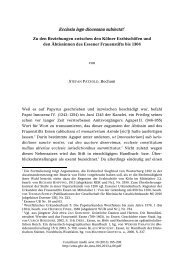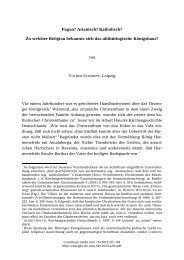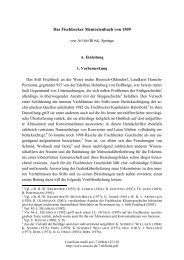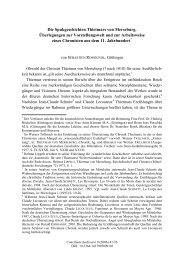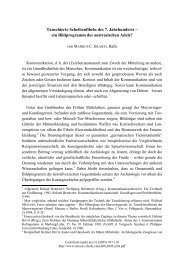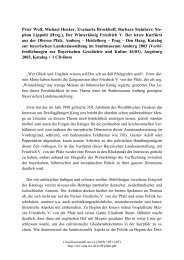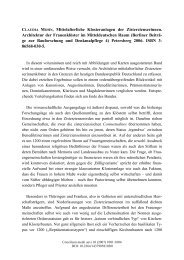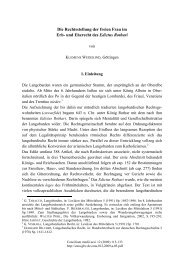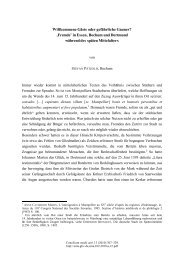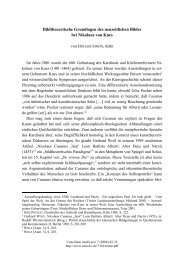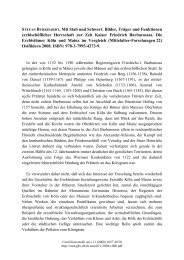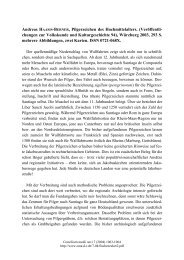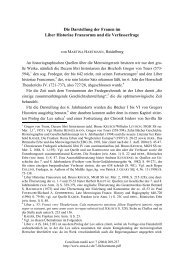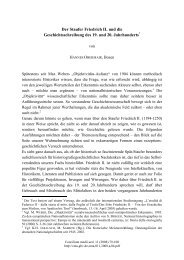Rabanus Maurus - Concilium medii aevi
Rabanus Maurus - Concilium medii aevi
Rabanus Maurus - Concilium medii aevi
You also want an ePaper? Increase the reach of your titles
YUMPU automatically turns print PDFs into web optimized ePapers that Google loves.
Rhetoric as praise of the emperor and<br />
applied politics of an education concept.<br />
The ‘res publica litteraria’ inside the monarchy. Alcuin of York and Rhabanus<br />
<strong>Maurus</strong> as representatives of the early rhetoric in Germany during the<br />
Renaissance of Charlemagne and the manuscript Albinus ad Regem.<br />
von FEE-ALEXANDRA HAASE, Hannover<br />
This article focuses on the establishment of the early rhetoric in Germany during the<br />
‘renaissance’ of Charlemagne. Alcuin and his pupil Rhabanus <strong>Maurus</strong> were prominent<br />
persons for the establishment of rhetoric and the artes liberales. The conception of<br />
education under Charlemagne was on the one hand based upon the artes liberales. On<br />
the other hand this ‘renaissance’ of ancient education was arranged under a different<br />
political system compared with the one, which was used in Rome and Greece. So the<br />
educational concept itself contains the interest of adornment and honour of the king<br />
perfectly used in the rhetorical dialogue between the king and the scholar Alcuin of<br />
York and the works of the first ‘Praeceptor Germaniae’ Rhabanus <strong>Maurus</strong>. The<br />
common term ‘Carolingian Renaissance’ refers to this culture of learning in the late 8 th<br />
century. Discussing the political function of the artes liberales with a special emphasis<br />
on the status of rhetoric and the manuscript Albinus ad Regem we see, how the ‘res<br />
publica litteraria’ inside the monarchy worked.<br />
In 800 the Frankish king Charlemagne became crowned emperor of the West.<br />
Charlemagne was a strong leader who unified Western Europe through military power<br />
and the blessing of the Church. Charlemagne saw the need for education of the<br />
Frankish people and started reforms for religious, political, and educational issues.<br />
Charlemagne – considered being himself a ‘homo illiteratus’ – promoted this<br />
educational goal by using himself as an example of a scholar of ancient culture at the<br />
top of the system and achieving the ability to read and write Latin and Greek. The time<br />
of Charlemagne was a period of great activity in the areas of later France and<br />
Germany.<br />
Charlemagne asked Alcuin to act as the head of the school system. While returning<br />
from Rome in March 781, Alcuin met Charlemagne at Parma, and moved to France<br />
and took up residence at the royal court as Master of the Palace School. The school<br />
was kept at the main place of the residence of the king, Aachen, most of the time. It<br />
<strong>Concilium</strong> <strong>medii</strong> <strong>aevi</strong> 8 (2005) 1-25<br />
http://www.cma.d-r.de/dr,cma,008,2005,a,01.pdf
2<br />
FEE-ALEXANDRA HAASE: Rhetoric as praise of the emperor<br />
was removed from place to place according to the change of the royal residence. In<br />
786 and again 790-793 Alcuin returned to England. Alcuin remained in France from<br />
the summer of 793 until his death, May 19, 804. Alcuin was an educator, scholar, and<br />
theologian. Alcuin’s educational writings are the treatises On Grammar, On<br />
Orthography, On Rhetoric and the Virtues, On Dialectics and the Disputation with<br />
Pepin. 1 In other words: The educational works consist of works dedicated for the<br />
trivium like De grammatica, De dialectica, De rhetorica and a fragment concerning<br />
music, De orthographia and the dialogue Disputatio Pippini cum Albino scholastico.<br />
The writings of Priscian, Donatus, Isidorus and Beda for grammar, of Cicero for<br />
rhetoric and from Augustine for dialectics were used by Alcuin. The language of<br />
Carolingian culture for the church and bureaucracy was Latin. For most people in<br />
Europe after the ‘barbarian invasions’ Latin was a foreign language. Charlemagne<br />
encouraged literacy in Latin, his own clergy being helped in this work by Anglo-Saxon<br />
and Irish monks, who had already had to develop methods of teaching Latin as a<br />
second language. Carolingian scholars made the copies of the Latin classics, which the<br />
humanists later discovered.<br />
According to Einhard (Eginhard), the Disputationes, and Alcuin’s correspondence,<br />
Charlemagne listened to his Anglo-Saxon advisor in all matters not political.<br />
Charlemagne’s Admonitio generalis stressed the importance of education. The<br />
academic scholars working at his court developed a concept based upon the ancient<br />
artes liberales. Among the clergy many of them were barely literate. Monks who spent<br />
their days copying manuscripts could barely read or understand them. Charlemagne<br />
wanted unity in the Frankish Church under his supervision. By this time the state<br />
needed the monastery schools to teach civic lessons in addition to Christian coverage.<br />
Einhard writes in the Vita Karoli Magni that eloquence was to be expressed in foreign<br />
languages and Charlemagne learned Greek and Latin:<br />
[25] Erat eloquentia copiosus et exuberans poteratque quicquid vellet apertissime<br />
exprimere. Nec patrio tantum sermone contentus, etiam peregrinis linguis ediscendis<br />
operam impendit. In quibus Latinam ita didicit, ut aeque illa ac patria lingua orare sit<br />
solitus, Grecam vero melius intellegere quam pronuntiare poterat. Adeo quidem<br />
facundus erat, ut etiam dicaculus appareret. 2<br />
1 http://www.newadvent.org/cathen/01276a.htm. [5.8.2002]<br />
2 http://www.gmu.edu/departments/fld/CLASSICS/ein.html#25. [3.9.2003]
FEE-ALEXANDRA HAASE: Rhetoric as praise of the emperor<br />
Charles had the gift of ready and fluent speech, and could express whatever he had<br />
to say with the utmost clearness. He was not satisfied with command of his native<br />
language merely, but gave attention to the study of foreign ones, and in particular was<br />
such a master of Latin that he could speak it as well as his native tongue; but he could<br />
understand Greek better than he could speak it.<br />
Einhard writes in the Vita Karoli Magni about the method of learning of the king:<br />
Temptabat et scribere tabulasque et codicellos ad hoc in lecto sub cervicalibus<br />
circumferre solebat, ut, cum vacuum tempus esset, manum litteris effigiendis<br />
adsuesceret, sed parum successit labor praeposterus ac sero inchoatus. 3<br />
He also tried to write, and used to keep tablets and blanks in bed under his pillow,<br />
that at leisure hours he might accustom his hand to form the letters; however, as he<br />
did not begin his efforts in due season, but late in life, they met with ill success.<br />
The biography written by Einhard is in general considered as a problematic source,<br />
since it obviously is not a historically objective source. But the text cited above gives<br />
us a good sample to discuss the function of ‘political literature’ of that time. On the<br />
one hand the author had the intention to promote the king’s authority and to put him on<br />
top of the educational system. This, of course, is also a common topos of philosophy<br />
going back to the sentence ‘kings to philosophers and philosophers to kings’<br />
mentioned by Socrates in The Republic, when discussing the ideal republic. Of course,<br />
in the concept used by Einhard the idea of the ideal republic is used for the idea, which<br />
later on became prominent as the ‘res publica litteraria’ in the 18 th century. A common<br />
topos in the literature written in the time of Charlemagne is that the king was educated<br />
according to the system he promoted. Einhard says in his vita of Charlemagne that the<br />
king had the gift of a ready and fluent speech and could express whatever he had to<br />
say with the utmost clearness. The king wasn’t satisfied with command of his native<br />
language merely, but gave attention to the study of foreign ones. According to Einhard<br />
Charlemagne was such a master of Latin that he could speak it as well as his native<br />
tongue; according to Einhard the king could understand Greek better than he could<br />
speak it. Einhard, although illiterate as a youth, presented Charlemagne, as fascinated<br />
by new ideas and to learning. Charlemagne studied subjects of the artes liberales such<br />
as Latin, Greek, rhetoric, logic and astronomy. Charlemagne was – according to<br />
3 http://www.gmu.edu/departments/fld/CLASSICS/ein.html#25. [3.9.2003]<br />
3
4<br />
FEE-ALEXANDRA HAASE: Rhetoric as praise of the emperor<br />
Einhard’s description – so eloquent, that he might have passed for a teacher of<br />
eloquence. We must consider these statements as part of the political ideology of that<br />
time and a praise of the king and following certain traditions of scholarly knowledge<br />
mentioned above. The realisation of this concept by using the ancient education<br />
system based upon the liberal arts. Einhard describes in Life of Charlemagne (25)<br />
Charlemagne as the mentor and cultivator of the artes liberales:<br />
Artes liberales studiosissime coluit, earumque doctores plurimum veneratus magnis<br />
adficiebat honoribus. In discenda grammatica Petrum Pisanum diaconem senem<br />
audivit, in ceteris disciplinis Albinum cognomento Alcoinum, item diaconem, de<br />
Brittania Saxonici generis hominem, virum undecumque doctissimum, praeceptorem<br />
habuit, apud quem et rhetoricae et dialecticae, praecipue tamen astronomiae<br />
ediscendae plurimum et temporis et laboris inpertivit. Discebat artem conputandi et<br />
intentione sagaci siderum cursum curiosissime rimabatur. 4<br />
He most zealously cultivated the liberal arts, held those who taught them in great<br />
esteem, and conferred great honors upon them. He took lessons in grammar of the<br />
deacon Peter of Pisa, at that time an aged man. Another deacon, Albin of Britain,<br />
surnamed Alcuin, a man of Saxon extraction, who was the greatest scholar of the day,<br />
was his teacher in other branches of learning. The King spent much time and labor<br />
with him studying rhetoric, dialectics, and especially astronomy; he learned to reckon,<br />
and used to investigate the motions of the heavenly bodies most curiously, with an<br />
intelligent scrutiny.<br />
According to the image of the philosophically educated king, which goes back to<br />
the Platonic idea of the sovereign as philosopher, Charlemagne joined the school of<br />
Alcuin, attended classes, and fulfilled his scholarly duties. In the school system of<br />
Charlemagne a text was read by a student or teacher accompanied by an explanation.<br />
So the genre dialogue is typical for the teaching system at that time. A master lectured<br />
on various subjects and there was a ‘disputation’. The student would be asked a<br />
multitude of questions and was forced to defend his position with logical arguments.<br />
This method of teaching was responsible for students learning to discipline their<br />
thoughts in Charlemagne’s day, and under the kings who followed, which used the<br />
canon of the artes liberales. 5<br />
4 http://www.noctes-gallicanae.org/Alcuin/Alcuin_epitaphe.htm. [3.9.2003]<br />
5 The text Caroli regis contra synodum from the 790s, traditionally called Libri Carolini, is written in<br />
opposition to the Byzantine empire and its rulers Irene and Constantine. Ommundsen investigated
FEE-ALEXANDRA HAASE: Rhetoric as praise of the emperor<br />
Compared to the artes liberales education in the ancient Roman time during the<br />
Middle Ages and Renaissance rhetoric – like other sciences of the system – was a tool<br />
for the access to theology and philosophy. Since the seven liberal arts of the trivium of<br />
grammar, rhetoric, and logic and the quadrivium of arithmetic, geometry, astronomy,<br />
and music were the ground for the access to philosophy and theology, a hierarchy<br />
existed according to contemporary political and social circumstances. 6 Students began<br />
their career in the faculty of arts. There they studied grammar, rhetoric and logic<br />
(trivium) next to arithmetic, astronomy, geometry and music (quadrivium). 7<br />
Isidore and Alcuin wrote an encyclopaedia of human knowledge, which included<br />
rhetoric and dialectic. Alcuin made a treatise on legal procedure in the form of a<br />
dialogue. Alcuin less describes in his book De Disputatio de Rhetorica et de virtutibus<br />
sapientissimi regis Carli et Albini Magistri rhetoric at the court of Charlemage;<br />
furthermore it is a propagandistic writing. So in the introduction Alcuin says that the<br />
one who desires to know the civil customs (civil customs) shall read the teachings<br />
(praecepta), which the book contains and which were written at the court of<br />
Charlemange who gave his ‘placet’ for it (ille probat) in this fictional pretext of coauthorship:<br />
Qui rogo civiles cupiat cognoscere mores,<br />
Haec praecepta legat, quae liber iste tenet.<br />
Scripserat haec inter curas rex Karulus aulae<br />
Albinusque simul: hic dedit, ille probat.<br />
Unum opus amborum, dispar sed causa duorum:<br />
Ille pater mundi, hic habitator inops.<br />
Neu temnas modico lector pro corpore librum:<br />
Corpore praemodico mel tibi portat apis. 8<br />
avout the role of the liberal arts in the Opus Caroli Regis: Å. OMMUNDSEN, The Liberal Arts and the<br />
Polemic Strategy of the Opus Caroli Regis Contra Synodum (Libri Carolini), in: Symbolae Osloenses.<br />
77/ 1 (2002) Pp. 175-200.<br />
6<br />
Cf.: Renaissance literary theory and practice. Classicism in the rhetoric and poetic of Italy, France,<br />
and England 1400-1600. Ed. with introduction by D.L. CLARK. 1939, Pp. 87-94.<br />
7<br />
C.D. LANHAM, Latin grammar and rhetoric from classical theory to medieval practice. 2002, Pp. 57-<br />
70.<br />
8<br />
http://www.gmu.edu/departments/fld/CLASSICS/alcuin.rhetorica.html. [9.6.2004]<br />
5
6<br />
FEE-ALEXANDRA HAASE: Rhetoric as praise of the emperor<br />
Important is here the fact that it is a writing getting its note of approval by<br />
censorship of the king. The text itself is according to the fact that it was written by<br />
Alcuin and accepted by Charlemagne not an authentic dialogue. The Disputatio de<br />
rhetorica et de virtutibus sapientissimi regis Carli et Albini magistri is the debate of<br />
the wise king and the teacher Alcuin about rhetoric and the virtues. As a moralizing<br />
political treatise the dialogue between Charlemagne and Alcuin the speakers describes<br />
that the proper subjects of rhetoric are politics, law and morals. The final section of the<br />
four cardinal virtues ends with honouring sentences for the king. 9 The sixteen chapters<br />
of the dialogue between the questioning pupil Charlemagne and the master Alcuin<br />
base on writings of Cassiodorus, Boethius, Cicero, Marius Victorinus, Julius Victor,<br />
Quintilian, and Pseudo-Augustine. The work distinguishes rhetoric as the art of<br />
disputation on practical matters from dialectic as the art of disputation on theoretical<br />
matters (theology). 10 The work On Rhetoric (Disputatio de rhetorica et de virtutibus<br />
sapientissimi regis Carli et Albini magistri) is a moralizing political treatise in form of<br />
a dialogue between Charlemagne and Alcuin. The dialogue closes with a final section<br />
on the four cardinal virtues. The sixteen chapters of dialogue between the questioner<br />
Charlemagne and the master Alcuin are based on Cassiodorus, Boethius, Cicero,<br />
Marius Victorinus, Julius Victor, Quintilian, and Pseudo-Augustine. Texts by the<br />
Church Fathers such as the Confessions by St. Augustine dealing with rhetoric issues<br />
were known to Alcuin. Alcuin’s Disputatio Pippini regalis et nobilissimi iuvenis cum<br />
Albino scholastico Alcuinus is a sample for the didactical literature of Alcuin in form<br />
of a dialogue. Although Alcuin’s importance as a central intellectual figure in the<br />
Carolingian Renaissance has never been seriously questioned, the quality of his<br />
literary production can be considered only part of the reason for his importance. His<br />
contemporary and rival Theodulf called him ‘nostrorum gloria vatum’. A letter to<br />
Aethilhard (Ep. 311) is evidence that Alcuin was still writing poetry at least as late as<br />
802. 11<br />
9 A first modern edition was made in 1841: Flaccus Alcuinus, The rhetoric of Alcuin and<br />
Charlemagne. A translation, with an introduction, the Latin text, and notes. 1941.<br />
10 See also: Introduction of: W.S. HOWELL, The rhetoric of Alcuin and Charlemagne. A translation.<br />
1941; A.F. WEST, Alcuin and the rise of the Christian schools. 1892 (Reprint 1969); H.V. FRIEDMAN,<br />
Rhetoric of Alcuin and Charlemagne (Howell), in: Classical Weekly (1942) Pp. 21-39, P. 25ff.<br />
11 P.D. SCOTT, Alcuin as a Poet. Rhetoric and Belief in his Latin Verse, in: University of Toronto<br />
Quarterly XXXIII (1964) Pp. 233-257; W. WILMANNS, Disputatio regalis et nobilissimi juvenis<br />
Pippini cum Albino scholastico, in: Zeitschrift für deutsches Altertum 14 (1869) Pp. 530-555;<br />
http://ub.leidenuniv.nl/bc/whs/catalogi/catcomp1/01.html. [15.9.2003]; Editions of Alcuin’s De<br />
Rhetorica: K. HALM, Rhetores Latini Minores, ex codicibus maximam partem primum adhibitis. 1863,<br />
Pp. 523-550.
FEE-ALEXANDRA HAASE: Rhetoric as praise of the emperor<br />
Alcuin introduced with his Disputatio de rhetorica et virtutibus the definition of<br />
rhetoric in a dialogue between him and Charlemagne:<br />
K. Unde dicta est rhetorica?<br />
K. Where does ‘rhetoric’ come from?<br />
A. Apo tou retoreuein, id est copia locutionis.<br />
A. ‘ Apo tou retoreuein’, this is the variety of speaking.<br />
K. Ad quem finem spectat?<br />
K. What is its purpose?<br />
A. Ad bene dicendi scientiam.<br />
A. The art of good speaking.<br />
K. In quibus versatur rebus?<br />
K. To which things is it related?<br />
A. To civil things, these are scholary questions […].<br />
A. In civilibus, id est doctis quaestionibus […]. 12<br />
Alcuin invoces the king with the words Dominus rex Karlus:<br />
A. Deus te, domine mi rex Karle, omni sapientiae lumine inluminavit et scientiae<br />
claritate ornavit, ut non solum magistrorum ingenia prompte subsequi, sed etiam in<br />
multis velociter praecurrere possis. 13<br />
A. God enlightened you, my master King Charles, with the light of total wisdom and<br />
decorated you with the clearness of science, so that you not only are able to follow<br />
immediately the intellect of the teachers, but also are able to proceed in many. 14<br />
In the Epistola de litteris colendis (784/85), for which Charlemagne is considered<br />
being the author, the docendi et discendi instantia is mentioned:<br />
12<br />
K. WERNER, Alcuin und sein Jahrhundert. Ein Beitrag zur christlich-theologischen<br />
Literaturgeschichte. 1876, Pp. 12ff.<br />
13<br />
http://freespace.virgin.net/angus.graham/Alcuin.htm. [2.2.2004]<br />
14<br />
http://freespace.virgin.net/angus.graham/Alcuin.htm. [2.2.2004]<br />
7
8<br />
FEE-ALEXANDRA HAASE: Rhetoric as praise of the emperor<br />
[...] ita quoque docendi et discendi instantia ordinet et ornet seriem verborum, ut,<br />
qui deo placere appetunt recte vivendo, ei etiam placere non neglegant recte<br />
loquendo. scriptum est enim: aut ex verbis tuis iustificaberis, aut ex verbis tuis<br />
condemnaberis (Matth. 12,37). quamvis enim melius sit bene facere quam nosse, prius<br />
tamen est nosse quam facere. debet ergo quisque discere, quod optat implere, ut tanto<br />
uberius, quid agere debeat, intellegat anima, quanto in omnipotentis dei laudibus sine<br />
mendaciorum offendiculis concurrerit lingua. 15<br />
For the trivium Alcuin chose the genre of the didactic dialogue to arrange the<br />
classical knowledge of ancient times in a new form. Alcuin’s Dialectica is structured<br />
the way the dialogue about the rhetoric is composed. Alcuin wrote five didactic works.<br />
All except one have the form of a dialogue. This form illustrates that many of his<br />
writings are used for the needs of his students. The Platonic tradition of the dialogue as<br />
method of education was renewed restoring the study of the liberal arts in Europe. The<br />
Ars grammatica consists of two parts: a conversation between Alcuin and his students;<br />
the grammar, in which a 14-year old Frankish pupil and a 15-year old Saxon pupil<br />
concern themselves mainly with morphology and etymology. De Orthographia is an<br />
alphabetical list of words, based mainly on Bede's De orthographia. The Disputatio de<br />
rhetorica et de virtutibus sapientissimi regis Carli et Albini magistri, The debate of the<br />
wisest king Charles and the teacher Alcuin, about rhetoric and the virtues is a<br />
moralizing political treatise, is a dialogue between Charlemagne and Alcuin.<br />
According to the edition of J.-P. Migne Alcuin’s work consists of letters, Exegetica,<br />
Dogmatica, Liturgica et Moralia, Hagiographica, poems such as inscriptions,<br />
epitaphia, epigrammata and Didascalia such as the writings Grammatica, De<br />
orthographia, Dialogus de rhetorica, De dialectica Pippini Regalis et nobilissimi<br />
juvenis disputatio cum Albino Scholastico. Dubia are Joannis Mabillonii disquisitio de<br />
antiquitate et auctore confessionis fidei sequentis Albini Confessio fidei Disputatio<br />
puerorum per interogationes et responsiones, Propositiones Alcuini doctoris ad<br />
acuendos juvenes Scripta alia nonnulla Alcuino dubitanter ascripta. On Computation<br />
was written in 820. 16 Alcuin composed more than 120 poems in hexameters, distichs,<br />
adonics with alliteration similar to that of Old English vernacular verse, sapphics, and<br />
15 Bibliotheca Augustana:<br />
http://www.fh-augsburg.de/~harsch/Chronologia/Lspost08/CarolusMagnus/kar_epli.html. [2.2.2004]<br />
16 Peter Dale SCOTT, Alcuin as a Poet. Rhetoric and Belief in his Latin Verse, in: University of<br />
Toronto Quarterly 33/3 (1964), Pp. 233-245, Pp. 235-250, P. 240f.
FEE-ALEXANDRA HAASE: Rhetoric as praise of the emperor<br />
freer liturgical forms, in a range of genres that included letters, history, hagiography,<br />
epitaphs, epigraphs, manuscript inscriptions or subscriptions, riddles, carmina figurata,<br />
prayers, nature poems, liturgy, poems on literary subjects, hymns, and more. One of<br />
the extant works is Coena’s epitaph in verse, but the next is the vast poem on York, so<br />
that his first compositions include his grandest and most impressive. A letter to<br />
Aethilhard is evidence that Alcuin was still writing poetry at least as late as 802. 17 This<br />
is another piece in the form of a dialogue between a master and his disciple. Much of it<br />
was copied from Bede’s De temporum ratione, Isidore’s Etymologies, and Boethius’<br />
Arithmetic. The resulting work marked an advance in instruction in the important<br />
matter of computing numbers, times and seasons. Isidorus Hispalensis dedicated the<br />
first and second book of the De etymologiarum libri XX to the trivium:<br />
Liber I De grammatica<br />
Liber II De rhetorica et dialectica<br />
Liber III De quatuor disciplinis mathematicis<br />
Liber IV De medicina<br />
Alcuin’s treatise on legal procedure was written in the form of a dialogue. Sprahha<br />
(eloquentia) is the Middle German language term for eloquence. Alcuin wrote in De<br />
Disputatio de Rhetorica about the parts of rhetoric according to the ancient scheme:<br />
Artis rhetoricae partes quinque sunt: inventio, dispositio, elocutio, memoria. 18 While<br />
Church Father Isidorus in his Etymologiarum libri XX simply tells the rhetorical<br />
categories, Alcuin adds examples taken from the Bible. So Isidore says ‘genera<br />
causarum tria sunt, deliberativum, demonstrativum, iudiciale’ (caput IV, 1), while<br />
Alcuin adds examples for each genus. Alcuin also mentions the three genres (genera)<br />
of speech (1.5) in his work De Rhetorica:<br />
17 http://freespace.virgin.net/angus.graham/Alcuin.htm. [2.3.2004]<br />
As secundary literature see: G. BAESECKE, Die Karlische Renaissance und das deutsche Schrifttum,<br />
in: Deutsche Vierteljahresschrift für Literaturwissenschaft und Geistesgeschichte 23 (1949) Pp. 178-<br />
181, 367.2; P. GODMAN, Poets and Emperors: Frankish Politics and Carolingian Poetry. 1987, Pp.<br />
25ff.; C. LEONARDI, Alcuino e la scuola palatina, in: Nascita dell’Europa carolingia. Un equazione da<br />
verificare, Settimane 27 (1981) Pp. 459-496; J.I. MCENERNEY, Alcuin, Carmen 58, in:<br />
Mittelateinisches Jahrbuch 16 (1981) Pp. 35-42; D. SCHALLER, ‘Alcuin’, in: Die deutsche Literatur<br />
des Mittelalters. Verfasserlexikon 1. Ed. by K. RUH et al. 1978, Cols. 241-53, Pp. 35-40ff.; P.D.<br />
SCOTT, Alcuin as a Poet: Rhetoric and Belief in his Latin Verse, in: University of Toronto Quarterly<br />
XXXIII (1964) Pp. 233-257. In Leiden, Library of the University, we find a manuscript: Disputatio<br />
Karoli regis et Albini (Alcuini) magistri sui de dialectica et virtutibus (fol. 61r-74r) 3. Sermones duo<br />
(fol. 74r-88v) 4. Tractatus de unione, quaestiones et responsa (fol. 89r-103r).<br />
18 http://www.gmu.edu/departments/fld/CLASSICS/alcuin.rhetorica.html. [5.8.2002]<br />
9
10<br />
FEE-ALEXANDRA HAASE: Rhetoric as praise of the emperor<br />
Ars rhetorica in tribus versatur generibus, id est demonstrativo, deliberativo et<br />
iudiciali. Demonstrativum genus, quod tribuitur in alicuius certae personae laudem<br />
vel vituperationem, ut in Genesi de Abel et Cain legitur: Respexit dominus ad Abel et<br />
ad.munera eius, ad Cain autem et munera eius non respexit. Deliberativum est in<br />
suasione et dissuasione, ut in Regum legitur, quomodo Achitophel suasit David citius<br />
perdere, et quomodo Chusai dissuasit consilium eius, ut regem salvaret. Iudiciale est,<br />
in quo est accusatio et defensio, ut in actibus legimus Apostolorum, quomodo Iudaei<br />
cum Tertullo quodam oratore Paulum accusabant apud Felicem praesidem, et<br />
quomodo Paulus se defendebat apud eundem praesidem. Nam in iudiciis saepius quid<br />
aequum sit quaeritur, in demonstratione quid honestum sit intellegitur, in<br />
deliberatione quid honestum et utile sit consideratur. 19<br />
The art of rhetoric is in three genres divided, these are the genus demonstrativum,<br />
the genus deliberativum and the genus judicale. The genus demonstrativum, in which<br />
praise or blame is dedicated to a person, like we red in the Genesis about Abel and<br />
Cain: The Lord had respect for Abel and his works, but for Cain the Lord had no<br />
respect. The genus deliverativum is related to suasion and dissuasion, just like we read<br />
in Kings how Achitophel suaded David to further perishing, and how Chusai dissuade<br />
his plan to save the king. The genus judicale is the one for accusations and defences,<br />
just like we read in the documents of the Apostles, how the people of Iudaea accused<br />
Paul with the help of an orator called Tertullus under the supervision of Felix, and<br />
how Paulus defended himself under this superivision. Because often in judgements is<br />
asked about equality, in a demonstration one thinks about what is honest and in a<br />
deliberation what is honest and usable.<br />
In his work De Rhetorica (1.4.) Alcuin mentions the parts of rhetoric:<br />
Artis rhetoricae partes quinque sunt: inventio, dispositio, elocutio, memoria,<br />
pronuntiatio. Inventio est excogitatio rerum verarum aut verisimilium, quae causam<br />
probabilem reddant: dispositio est rerum inventarum in ordinem distributio: elocutio<br />
est idoneorum verborum ad inventionem accommodatio: memoria est firma animi<br />
rerum ac verborum A.D. inventionem perceptio: pronuntiatio est ex rerum et verborum<br />
dignitate vocis et corporis moderatio. 20<br />
19 http://www.freespace.virgin.net/angus.graham/Alc-Rhet.htm. [5.8.2002]<br />
20 http://freespace.virgin.net/angus.graham/Alcuin.htm. [5.8.2002]
FEE-ALEXANDRA HAASE: Rhetoric as praise of the emperor<br />
In the art of rhetoric the five parts are: Invention (inventio), disposition (dispositio),<br />
elocution (elocutio), memory (memoria), delivery (pronuntiatio). The inventio is the<br />
finding of true things or things that appear true that lead to the causa probabilis,<br />
dispositio is the distribution of the invented things in a scheme. Elocutio is the<br />
accommodation of the accurate words for the invention. Memoria is the solid<br />
perception of things and words in the mind. Delivery is the moderation of the coice<br />
and body from the dignity of things and words.<br />
For the question of the relation between the king and Alcuin the document Albinus<br />
ad regem is very interesting. The document is a letter of advice in Latin; the first part<br />
is a plain text and the second part put in the scheme of the majuscules A and L. A<br />
codex now in Köln (Köln, Dombibliothek, Codex 106. Darmst. 2106) is a very<br />
interesting manuscript concerning the relation between the scholar Alcuin and the<br />
king. Written about 810 at Werden a. d. Ruhr in the Benediktinerabtei St. Ludger in<br />
Latin in Carolingian minuscules the codex contains in Fol. 2r-59v copies of Alcuin:<br />
Enchiridion (including Fol. 5v De octo vitiis principalibus, Fol. 17r-17v Versus de<br />
contemptu mundi, Fol. 22r-22v Orationes de septem psalmis poenitentialibus, Fol.22v<br />
De oratione dominica, Fol. 23r-26v Alcuinus: Epistola ad pueros sancti Martini de<br />
confessione peccatorum, Fol. 26v Ad regem, Fol. 44r Hymni, Fol. 44v-45r. The<br />
manuscript Ad regem contains no paragraph signs. Words do not close up with line<br />
endings.<br />
Albinus Ad Regem<br />
Fuganda sunt omnimodis et abscidenda ac ferro totoque<br />
artificio separanda: Languor a corpore, imperi-<br />
tia ab animo, luxoria a ventre, a civitate sedicio,<br />
a domo discordia et in commune a cunctis rebus<br />
intemperantia. Amicorum debent esse cuncta com-<br />
munia. Duorumque temporum maxime haben-<br />
da cura mane et vespere: et eorum qui aucturi su-<br />
mus et eorum quae gesserimus. Post deum veritas<br />
maxime colenda.<br />
In the letter Albinus ad regem the king is advised, that the following habits are to be<br />
avoided (fuganda sunt ) in any way:<br />
Inactivity from the body<br />
11
12<br />
FEE-ALEXANDRA HAASE: Rhetoric as praise of the emperor<br />
Ignorance from the mind<br />
Abundance from the stomach<br />
Dissension from citizenship<br />
Disagreement from the home<br />
and in the community extravagance from all things.<br />
Furthermore, the king is advised that all of the friends has to be common. Special<br />
emphasis he puts on the two times morning and evening and finally closes the letter<br />
with the notice, that after god the truth (veritas) is mostly to collect.<br />
This riddle follows the text of the letter:<br />
A stateram ne transilias<br />
F id est iusticiam ne proptergradiaris<br />
A (i)gnem gladio ne fodias<br />
F id est iratum videlicet verbum maledicis lacessias<br />
A coronam minime carpas<br />
F id est leges urbium conserves<br />
A cor non comedas<br />
F id est merorem de animo proiece<br />
A cum profectus fueris ne redeas<br />
F id es post mortem vitam istam ne desideras<br />
A per viam publicam ne ambules<br />
F (id est) multorum errores non sequaris<br />
A hirundinem in domo ne suscipias<br />
F id est garrulos et verbosos homines sub eodem tecto non habeas<br />
A oneratis onus suppone<br />
(F) id est ad virtutem incedentibus auge praecepta<br />
A deponentibus non communices<br />
F id est tradentibus se otio relinque 21<br />
Since the text is a copy and so does not contain any criteria for the time of the<br />
writing, we can only look at the contents and style of the text: The letter is addressed<br />
finally to an unknown person, only the title indicates the king and Alcuin. In<br />
opposition to Alcuin’s written documents, which relay to the artes liberales, this<br />
document is only concerned with ethical questions and has a very pragmatic focus on<br />
them. These general advices are in their style and quality directed towards a person in<br />
21 The text taken from Dom.-Hs 106, Fol. 26v was edited at: Archiv der Gesellschaft für ältere<br />
deutsche Geschichtskunde 7 (1839) Pp. 857-858.
FEE-ALEXANDRA HAASE: Rhetoric as praise of the emperor<br />
a higher or even the highest position, but also contain advises for general lifeconduction.<br />
Derived from Secundus Symphosius and an anonymously written disputation<br />
between Hadrian and Epictetus, the Disputatio regalis et nobilissimi juvenis Pippini<br />
cum Albino scholastico (The dispute of the royal and most noble young man Pippin<br />
with the teacher Albinus) provides another pedagogical dialogue, this time with the<br />
son of Charlemagne. The main didactic method used by Alcuin was the question and<br />
answer scheme. We find this in the teachings and in the dialogues. It can be considered<br />
as a rhetorical concept. The dialogue between Pippin and Alcuin is composed in<br />
question and answer. If we compare now the dialogues between Pippin and Alcuin as<br />
well as between Charlemagne and Alcuin, we first have to ask about their origin, time,<br />
purpose and authenticity. So the first dialogue could have been only homage to Pippin<br />
later made by his son Charlemagne in order to establish him in the annals as the<br />
legitimate emperor following Pippin. 22 While we find as topic of the dialogue between<br />
Pippin and Alcuin the definition of main elementary things such as things and abstract<br />
values in an encyclopaedic approach, which establishes his text in one tradition of<br />
educational literature with Comenius’ Orbis pictus, the dialogue with Charlemagne<br />
focuses only on rhetoric in the tradition of the ancient rhetorical concepts and allows<br />
derivations only as exempla. Alcuin invokes Charlemagne with the title ‘rex’ and is<br />
respected by the king for his ability to open the subtle value of rhetoricae artis vel<br />
dialecticae. In the dialogue with Pippin no special invocation of the king is made. So<br />
this demonstrates the importance of the dialogues to represent the king Charlemagne,<br />
while Pippin is the basic elementary background expressed with the encycopedic<br />
approach of the text. His son is object of rhetorical honor when Alcuin says, that God<br />
made Charlemagne great (magnus) and beautiful (beatus): ‘Magnum te faciat Deus et<br />
vere beatum, domine mi rex […].’<br />
22 For the editorial history of Pippini Regalis et Nobilissimi Juvenis Disputatio cum Albino Scholastico<br />
see: A text edition of Pippini Regalis et Nobilissimi Juvenis Disputatio cum Albino Scholastico was<br />
made by Jean Lauand: Pippini Regalis et Nobilissimi Juvenis Disputatio cum Albino Scholastico (PL<br />
101, 975-980). One copy of the Disputatio Pippini cum Alcuino is the Ms 808 in the Österreichische<br />
Nationalbibliothek, Vienna. Pippini Regalis et Nobilissimi Juvenis Disputatio cum Albino Scholastico<br />
(PL 101, 975-980). Monitum pr<strong>aevi</strong>um. Cl. Quercetanus Disputationem quae sequitur edidit juxta<br />
exemplar impressum Hamburgi anno 1615. In codice ms. Salisburgensi 900 annorum eadem<br />
Disputatio exstat media inter epistolas et carmina Alcuini, absque tamen auctoris nomine; e quo<br />
lectiones variantes adnotavimus. Modern print editions: Philosophus Secundus; Publius Aelius<br />
Hadrianus; Epictetus; Albinus Diaconus, Altercatio Hadriani Aug. et Epicteti philosophi; Item<br />
Disputatio Pippini et Albini scholastici. Haer nova; illa auctior prodit. Ed. H. LINDENBROG. Hamburgi<br />
1615; Flaccus Alcuinus, Gespräch des jungen hochedlen Königssohns Pippin mit seinem Lehrer<br />
Albinus [Disputatio Pippini et Albini]. 1880.<br />
13
14<br />
FEE-ALEXANDRA HAASE: Rhetoric as praise of the emperor<br />
Alcuin’s pupil Hhabanus (Rrabanus, <strong>Rabanus</strong>) <strong>Maurus</strong>, known as the first<br />
‘Praeceptor Germaniae’, was born in 780 in Mainz, Germany. 23 At the time of<br />
Hrabanus’ birth, Charlemagne was ruling from his capital in Aachen, after having been<br />
crowned King of Franks in 768. Around 790 Hhabanus entered a monastery in Fulda,<br />
which was a centre of learning in Germany at the time. In 801 Hhabanus moved to<br />
France, where he studied under Alcuin, a leading figure of the ‘Carolingian<br />
Renaissance’. Rhabanus <strong>Maurus</strong>’ book De natura contains passages about rhetoric. 24<br />
Although it is not a book containing all elements of rhetoric known in ancient time, we<br />
find here parts derived from the Latin rhetoric and specific ones for a certain style of<br />
speech. Next to the expression orationes legitimae Rhabanus uses the expression<br />
oratio pecularis:<br />
XI. de pecularibus orationibus<br />
Peculiares autem orationes pure et frequenter facere et bonum et laudabile est, quia<br />
multorum patrum exempla id nos facere suadent, et ipse domunus etiam suo<br />
gamisterio hoc docere nos dignatus est dicens: "Tu autem, cum oraveris intra in<br />
cubiculum et clauso ostio, ora patrem tuum, et pater tuus, qui videt in abscondito,<br />
reddet tibi." 25<br />
Alcuin’s work includes genres such as poems, letters, history, hagiography,<br />
epitaphs, epigraphs, manuscript inscriptions or subscriptions, riddles, carmina figurata,<br />
prayers, nature poems, liturgy, poems on literary subjects, hymns, and more. Alcuin’s<br />
Propositiones are composed as little riddles (aenigmata) in the scheme of propositio<br />
and solutio:<br />
XIX. PROPOSITIO DE VIRO ET MULIERE PONDERANTIBUS. De viro et<br />
muliere, quorum uterque pondus habebat plaustri onusti, duos habentes infantes inter<br />
utrosque plaustrali pondere pensantes fluvium transire debuerunt. Navem invenerunt<br />
23 Basic editions and works on <strong>Maurus</strong>: B. Rabani Mauri Fuldensis abbatis et Moguntini archiepiscopi<br />
opera omnia accurante J.-P. Migne. T. 2. Edited by J.-P. MIGNE. 1990; M. RISSEL, Rezeption antiker<br />
und patristischer Wissenschaft bei Hrabanus <strong>Maurus</strong>. Studien zur karolingischen Geistesgeschichte.<br />
1976; <strong>Rabanus</strong> <strong>Maurus</strong>, Die sieben freien Künste. 1879; <strong>Rabanus</strong> <strong>Maurus</strong>, Poemata de diversis. Nunc<br />
primum vulgata et scholiis illustrata. S. l., s.t. (1617).<br />
24 W. SCHIPPER, The Earliest Manuscripts of <strong>Rabanus</strong> <strong>Maurus</strong>’ De rerum naturis (Karlsruhe, Badische<br />
Landesbibliothek, MS Aug. 68 and Vienna, Österreichische Nationalbibliothek MS 121), in: Brills<br />
Studies in Intellectual History 79 (1997) Pp. 363-380.<br />
25 Hrabanus <strong>Maurus</strong>, De institutione clericorum libri tres. Studien und Editionen von D. ZIMPEL<br />
(Freiburger Beiträge zur mittelalterlichen Geschichte. Studien und Texte 7) 1996, P. 352. Lib II, XI.
FEE-ALEXANDRA HAASE: Rhetoric as praise of the emperor<br />
quae non poterat ferre plus nisi unum pondus plaustri. Transfretari faciat, qui se putat<br />
posse, ne navis mergatur.<br />
XIX. Solutio. Eodem quoque ordine, ut superius. Prius intrassent duo infantes et<br />
transissent: unusque ex illis reduceret navem. Tunc mater navem ingressa transisset.<br />
Deinde filius ejus reduceret navem. Qua transvecta frater illius navim ingressus ambo<br />
ultra transissent, rursusque unus ex illis a patrem reduceret navem. Qua reducta, filio<br />
foris stante, pater transiret: rursusque filius, qui ante transierat, ingressus navim<br />
eamque ad fratrem reduceret: jamque reductam ingrediantur ambo et transeant. Tali<br />
subremigante ingenio erit expleta navigatio forsitan sine naufragio. 26<br />
Rhabanus <strong>Maurus</strong> writes in De rerum naturis (Book 15): Rhetorica est disciplina ad<br />
persuadendum quodque idonea. Sicut enim omnis uir prophetans uel uates dicitur uel<br />
propheta, ita omnis femina prophetans sibilla. 27 <strong>Maurus</strong> also described the art of<br />
rhetoric in his encyclopaedic work. During 9 th and 10 th century only a few<br />
developments of rhetoric were made. The 9 th century was often considered as a time of<br />
decadence of rhetoric. In the 9 th century Rhabanus <strong>Maurus</strong> also described the art of<br />
rhetoric in his encyclopaedic work. During 9 th and 10 th century only a few<br />
developments were made on rhetoric. Rhrabanus <strong>Maurus</strong> later returned to Fulda,<br />
where he was abbot from 822 to 842. Rhabanus was later appointed Bishop of Mainz.<br />
Rhabanus died in Mainz on February 4, 856. His feast day is celebrated in Mainz on<br />
February 4 and he is often referred to as the ‘blessed’ although he was never beatified<br />
or canonized. Rhabanus is known as the author of encyclopaedic and scholarly works,<br />
along with sermons and poems. De universo and De rerum naturis were Hrabanus’s<br />
encyclopaedia of worldly knowledge. His picture-poems were named De laudibus<br />
sanctae crucis. Rhabanus’ encyclopaedia De rerum naturis often covers the same<br />
ground as Saint Augustine. Many important academic reforms were initiated with<br />
Charlemagne's support, including efforts to standardize Latin writing with the use of a<br />
new script. This alphabet, called the Carolingian alphabet, introduced lower case<br />
letters into the writing system. Hrabanus <strong>Maurus</strong> was one of the great educators of the<br />
Carolingian age and his De rerum naturis is one of the most notable productions of the<br />
period. It relies heavily on earlier works, such as the Etymologiae of Isidore of Seville<br />
26 http://www.thelatinlibrary.com/alcuin/alcuin.propos.shtml. [7.7.2004]<br />
See also: M. FOLKERTS, Die älteste mathematische Aufgabensammlung in lateinischer Sprache. Die<br />
Alcuin zugeschriebenen Propositiones ad acuendos iuvenes. Überlieferung, Inhalt, kritische Edition.<br />
1978.<br />
27 http://www.mun.ca/rabanus/drn/15.html. [7.7.2004]<br />
15
16<br />
FEE-ALEXANDRA HAASE: Rhetoric as praise of the emperor<br />
(560-636), while paving the way for later medieval encyclopaedias, such as the works<br />
of Thomas of Cantimpré and Vincent of Beauvais.<br />
Hrabanus describes in book 15 of De natura the genders of philosophy (de<br />
philosophis gentium):<br />
Dialectica est disputatio acuta uerum distinguens a falso. Rhetorica est disciplina<br />
ad habentes quidam nomina ex auctoribus, ut Platonici, Epicurei, Pitagorici.<br />
(Dialectica is an acute dispute to divide truth from false. Rhetorica is the discipline<br />
of having certain names from authors like Plato, Epicure, Pythagoras.) <strong>Maurus</strong><br />
divides into the branches of Logica, seven branches of Phisica (sic!), Ethica with her<br />
for parts Prudentia, Iustitia, Fortitudo and Temperantia. Logica, Dialectica and<br />
Rhetorica are another group of philosophy.<br />
In other words: <strong>Maurus</strong> divides the philosophi into three genders (‘Idem autem<br />
philosophi triplici genere dividuntur. Nam autem phisici sunt etheci aut logici.’). 28 In<br />
Book 15 of De rerum naturis Rhabanus also divides genders (gentes) of philosophers,<br />
poets, sibylls, magicians, pagans and gods. 29<br />
De philosophis gentium<br />
De poetis<br />
De sibillis<br />
De magis<br />
De paganis<br />
De diis gentium<br />
Rhabanus classifies the sophists as sapientes aut doctores sapientiae (liber XV [1]):<br />
Nam dum antea Greci ueteres sophistas, id est sapientes aut doctores sapientiae,<br />
semetipsos Iactantius nominarent, iste interrogatus quid profiteretur, uerecundo<br />
nomine philosophum, id est amatorem sapientiae se esse respondit. Quoniam<br />
sapientem profiteri arrogantissimum uidebatur, ita deinceps posteris placuit, ut<br />
quantalibet de rebus ad sapientiam pertinentibus doctrina quisque uel sibi uel aliis<br />
28 http://penelope.uchicago.edu/Thayer/L/Roman/Texts/Isidore/8*.html. [7.7.2004]<br />
29 M.A. MAYESKI, “Let Women Not Despair”. <strong>Rabanus</strong> <strong>Maurus</strong> on Women as Prophets, in:<br />
Theological Studies 58/2 (1997) Pp. 237-250.
uideretur excellere. 30<br />
Philosophi<br />
Philosophi fisici<br />
Philosophi fisi<br />
Philosophi ethici<br />
Philosophi logici<br />
Phisica<br />
Arithmetica<br />
Astronomica<br />
Astrologia<br />
Mechanicia<br />
Medicina<br />
Geometrica<br />
Musica<br />
Ethica<br />
Prudentia<br />
Iustitia<br />
Fortitudo<br />
Temperantia<br />
Logica<br />
Dialectica<br />
Rethorica<br />
FEE-ALEXANDRA HAASE: Rhetoric as praise of the emperor<br />
Augustine definies in De Dialectica (liber I.) dialectics as the science of good<br />
dispute:<br />
Dialectica est bene disputandi scientia. Disputamus autem utique verbis. Verba<br />
igitur aut simplicia sunt aut coniuncta. Simplicia sunt quae unum quiddam significant<br />
ut cum dicimus ‘homo equus disputat currit’. Nec mireris, quod ‘disputat’, quamvis ex<br />
duobus conpositum sit, tamen inter simplicia numeratum est; nam res definitione<br />
inlustratur.<br />
30 Rhabanus <strong>Maurus</strong>: De rerum naturis. Book 15: http://www.mun.ca/rabanus/drn/15.html. [7.7.2004]<br />
17
18<br />
FEE-ALEXANDRA HAASE: Rhetoric as praise of the emperor<br />
Dialectica is the science of the good dispute. We have a dispute by the use of words.<br />
Words are either single or conjunct. Single ones are those, which signify one thing like<br />
when we say ‘man horse dispute run’. If is not a wonder that ‘dispute’, although it is<br />
composed out of two, is considered as a simple one, because the thing is illustrated by<br />
the definition. Dialectica is the acute disputation to divide the true from the false.<br />
Rhetorica is the discipline to choose what is appropriate for persuasion.<br />
Rhabanus definies dialectica and rhetorica:<br />
Dialectica est disputatio acuta uerum distinguens a falso. Rhetorica est disciplina<br />
ad persuadendum quodque idonea. 31<br />
While rhetoric is the art of disputation on practical matters, dialectic is the art of<br />
disputation on theoretical matters. The concept under which Rhabanus re-organised<br />
the human science on the one hand by the exchange of a hierarchical system between<br />
philosophy and the artes liberales and the artes mechanicae, which dominated later<br />
Renaissance culture. Rhabanus put together instead of this sciences of philosophy,<br />
artes liberales and artes mechanicae. Although Rhrabanus provides his readers with<br />
some ‘secular’ or ‘worldly’ learning, you will see that in these paragraphs about the<br />
world itself Rhabanus is always revolving within the boundaries of learning<br />
determined by the Biblical text and, perhaps even more important, the ritual language<br />
of the Catholic Church itself, which was Latin. By the 8 th century, Jerome's Vulgate<br />
translation of the Bible had become universally adopted throughout Western Europe.<br />
Yet when it comes to the Psalms, you will find that the citations of the Psalms in<br />
Rhabanus’ work often do match the Vulgate. 32<br />
In 822 Rhabanus was elected for the position as an abbot. During his reign the<br />
monastery enjoyed its greatest prosperity. Rhabanus completed the new buildings that<br />
had been begun by his predecessor. Rhabanus erected more than thirty churches and<br />
oratories. Rhabanus was buried in the monastery of St. Alban at Mainz, but<br />
Archbishop Albrecht of Brandenburg transferred his relics to Halle. Rhabanus was<br />
probably the most learned man of his age. In Scriptural and patristic knowledge he had<br />
31 Rhabanus <strong>Maurus</strong>: De rerum naturis. Book 15: http://www.mun.ca/rabanus/drn/15.html. [7.7.2004]<br />
32 Cf. for the reception of the artes liberales: F. DECHANT, Die theologische Rezeption der artes<br />
liberales und die Entwicklung des Philosophiebegriffs in theologischen Programmschriften des<br />
Mittelalters von Alcuin bis Bonaventura. 1993.
FEE-ALEXANDRA HAASE: Rhetoric as praise of the emperor<br />
no equal. Rhabanus was thoroughly conversant with canon law and liturgy. Rhabanus’<br />
literary activity extended over the entire field of sacred and profane learning as then<br />
understood. Rhabanus followed in the beaten track of his learned predecessors. 33 Also<br />
other scholars of the Carolingian empire took part in the educational concept of<br />
Charlemagne. Modoinus (ca. 770-840/43) praises in his Ecloga ad Karolum (Prologus<br />
Liber prior Liber posterior Epilogus) the emperor:<br />
Caesareis, Karolus sapiens, hec auribus hauri<br />
Carmina, que nulla sunt peritura die,<br />
Dum rapidis sol currit equis, vibramine terras<br />
Inlustrat, gelidis dum mare fervet aquis,<br />
Epistola Theodulfi ad Modoinum. 34<br />
In the Rescriptum Modoini ad Theodulfum it is mentioned that no one can play,<br />
speak or care about the art correctly without right:<br />
Modoinus indignus episcopus Theodulfo suo.<br />
Ludere nemo potest versu sine lege polito,<br />
Nempe loqui recte nec valet arte carens.<br />
Sed prius accipiter nec temptat vivere in armis,<br />
Quam instructus proprii hoc more parentis agat. 35<br />
Most of Rhabanus’ works have been edited by Colvenerius in Cologne in 1627. His<br />
chief pedagogical works are De universo, a sort of encyclopaedia in 22 books, based<br />
on the Etymologies of Isidore, De computo, a treatise on reckoning and the Excerptio<br />
de arte grammatica Prisciani, a treatise on grammar. Other important works are De<br />
ecclesiastics discipline, sermons, treatises, a martyrology, and a penitential. The<br />
tradition of advising in rhetoric came traditionally from the relation father to son and<br />
later on developed into the broader relation of teacher and student, which was adapted<br />
by Alcuin. Later, Albertanus of Brescia writes in his trease to the son entitled loquendi<br />
et tacendi six questions used as conditions for speech:<br />
[...] sed linguam nemo domare potest: ideo ego, Albertanus, brevem doctrinam<br />
33 Raymund KOTTJE, Hrabanus <strong>Maurus</strong> – “Praeceptor Germaniae”?, in: Deutsches Archiv für<br />
Erforschung des Mittelalters 31 (1975) Pp. 534-545.<br />
34 http://www.fh-augsburg.de/~harsch/Chronologia/Lspost09/Modoinus/mod_intr.html. [7.7.2004]<br />
35 http://www.fh-augsburg.de/~harsch/Chronologia/Lspost09/Modoinus/mod_resc.html. [7.7.2004]<br />
Text in: MGH Poet. I, pp. 569-73 ed. Ernst DÜMMLER. 1881.<br />
19
20<br />
FEE-ALEXANDRA HAASE: Rhetoric as praise of the emperor<br />
super dicendoatque tacendo, uno versiculo comprehensam, tibi filio meo, Stephano,<br />
traderecuravi. Versiculus hic est: Quis, quid, cui dicas, cur, quomodo, quando,<br />
requiras. 36<br />
But the language no one can control: that is why I, Albertanus, made a concise<br />
teaching advice about speaking and silence only in one verse for you, my son,<br />
Stephanus. The little verse is the following: Who, What, to whom you speak, why, in<br />
which way, when is required.<br />
In De rerum naturis (Book 5) Rhabanus describes the oration (oratio) in De<br />
oratione et ieiunio:<br />
5.13 De simbolo<br />
[14] De oratione et ieiunio<br />
Oratio petitio dicitur, nam orare est petere, sicut exorare in petrare. Constat autem<br />
oratio loco et tempore […]. 37<br />
About the symbol<br />
About the oratio<br />
The oratio is called a petition, because orare means to make a petition, just like<br />
‘exorare’ in ‘petrare’. But the place and time of the oratio are fixed.<br />
Clement of Alexandria looked for meaning on four plains, the natural, the mystical,<br />
the moral, and the prophetic. The threefold sense as used by Origen included the<br />
allegorical, the tropological, and the analogical, to which Rhabanus <strong>Maurus</strong> also added<br />
the historical. The Pietistic method of interpretation is similar but the rules of grammar<br />
and the common meaning and usage of words are discarded and the eternal light of the<br />
spirit is held to be abiding and infallible Revealer. The problems start when<br />
interpreters have contradictory revelations because each person has no authority but<br />
himself, and his own subjective feeling or fancy is the end of the controversy.<br />
Rhabanus speaks in the preface of De rerum naturis (preface 1) about the invention<br />
of the manifestation of history (hystoriae) and allegory (allegoriae): Et sic satis facere<br />
quodammodo posset suo desiderio in quo et hystoriae et allegoriae inueniret<br />
manifestationem. 38 Carl Joachim Classen already mentioned that Marurs in his De<br />
36 http://www.thelatinlibrary.com/albertanus/albertanus.arsloquendi.shtml.<br />
37 De rerum naturis. Book 5. http://www.mun.ca/rabanus/drn/5.html. [7.7.2004]<br />
38 Cf.: http://www.mun.ca/rabanus/drn/pref1.html. [7.7.2004]
FEE-ALEXANDRA HAASE: Rhetoric as praise of the emperor<br />
institutione clericorum took elements of Melanchthon’s De Rhetorica libri tres. By the<br />
end of the 11 th century, Western Europe had made some remarkable advances in a<br />
number of areas. 39 Many of the often-quoted statements about Charlemagne and<br />
literacy derive from the work of his contemporary biographer Einhard. This work is<br />
known to be defective in such matters as chronological detail, and presents an<br />
idealised portrait of the great man in the mode of classical writers describing Roman<br />
emperors. Rhabanus writes in his preface of De rerum naturis called Domino<br />
excellentissimo et omni honore dignissimo Hludouuico regi that nearly in every part of<br />
Europe Charlemagne is praised:<br />
Rhabanus uilissimus seruorum dei seruus aeterne beatitudinis in Christo optat<br />
salutem. Audita bona opinione uestra quae predicatur per totas prouincias Germaniae<br />
atque Galliae. Et pene in cunctis partibus Europae crebris laudibus intonant satis<br />
exulto, et domini misericordiam imploro quatinus hoc cum bono augmento ad<br />
salubrem finem peruenire concedat. 40<br />
Rhabanus’ writings fall into various classes. Among those of an exegetical nature,<br />
the earliest is his commentary on Matthew written between 814 and 822. It is less an<br />
original work than a compilation, especially from Jerome, Augustine, and Gregory the<br />
Great. Commentaries followed on the other historical books of the Old Testament,<br />
with the exception of Ezra and Nehemiah, and including Maccabees. Then he<br />
explained Wisdom and Ecclesiasticus, Isaiah, Jeremiah, Ezekiel, and Daniel. To a later<br />
period probably belong the commentaries on Proverbs, the Pauline epistles, and the<br />
Gospel of John. Of these there are yet unpublished Isaiah (a 12 th -century manuscript in<br />
the possession of Erlangen University), Daniel and John (Munich Library). 41 Burgess<br />
39 R. MCKITTERICK, ZIMPEL (ed.), <strong>Maurus</strong> Hrabanus, De institutione clericorum libri tres. Studien und<br />
Edition, in: Journal of ecclesiastical history 49/2 (1998) P. 343-370, P. 350ff.<br />
40 http://www.mun.ca/rabanus/drn/pref1.html. [7.7.2004]<br />
41 Medieval Latin. The Latin Library. The Classics Homepage:<br />
http://www.ccel.org/s/schaff/encyc/encyc09/htm/iv.vii.htm. [7.7.2004]<br />
Bibliography <strong>Rabanus</strong> <strong>Maurus</strong>: The Opera. Ed. by J. PAMELIUS, A. DE HENIN and G. COLVENERIUS. 6<br />
vols. Cologne 1626-1627; <strong>Rabanus</strong> <strong>Maurus</strong>: http://www.ccel.org/s/schaff/hcc4/htm/i.xiv.xxvi.htm.<br />
[7.7.2004]; <strong>Rabanus</strong> <strong>Maurus</strong>, Opera omnia, in: MIGNE, Tom. CVII.-CXII; <strong>Rabanus</strong> <strong>Maurus</strong>, Carmina,<br />
in: Dümmler’s Poetae Latini <strong>aevi</strong> Carolini, II, Pp. 159-258; Hrabanus <strong>Maurus</strong>, De rerum naturis. Il<br />
codice 132 dell’Archivio di Montecassino. Università degli Studi di Cassino. 1996; M. BAYLESSS,<br />
Alcuin’s Disputatio Pippini and the early medieval riddle tradition, in: Humour, History and Politics in<br />
Late Antiquity and the Early Middle Ages. Ed. by Guy HALSALL. 2002, Pp. 157-178; C. CHARLIER,<br />
Alcuin, Florus et l’ Apocryphe hiéronymien “Cogitis me” sur l’ Assomption, in: Studia Patristica I.<br />
Papers presented to the Second International Conference on Patristic Studies held at Christ Church.<br />
1957. Part I. Edited by K. ALAND and F. L. CROSS (Texte und Untersuchungen zur Geschichte der<br />
altchristlichen Literatur 63 = V. Reihe 8). 1957, Pp. 70-81; F.A. S.: Rhabanus <strong>Maurus</strong>, der Gründer<br />
21
22<br />
FEE-ALEXANDRA HAASE: Rhetoric as praise of the emperor<br />
Collection at University Oregon contains <strong>Rabanus</strong> <strong>Maurus</strong>’ Commentary on the Book<br />
of Numbers. 42<br />
Charlemagne in Epistola de litteris colendis, a work alternatively ascribed to<br />
Einhard, mentiones parts of the rhetorical system. 43<br />
Quamobrem hortamur vos litterarum studia non solum non neglegere, verum etiam<br />
humillima et deo placita intentione ad hoc certatim discere, ut facilius et rectius<br />
divinarum scripturarum mysteria valeatis penetrare. cum enim in sacris paginibus<br />
scemata, pi et cetera his similia inserta inveniantur, nulli dubium, quod ea<br />
unusquisque legens tanto citius spiritualiter intelligit, quanto prius in litteraturae<br />
magisterio plenius instructus fuerit. tales vero ad hoc opus viri eligantur, qui et<br />
voluntatem et possibilitatem discendi et desiderium habeant alios instruendi. et hoc<br />
totum ea intentione agatur, qua devotione a nobis praecipitur. 44<br />
In the Epistola de litteris colendis the docendi et discendi instantia is mentioned:<br />
[…] ita quoque docendi et discendi instantia ordinet et ornet seriem verborum, ut,<br />
qui deo placere appetunt recte vivendo, ei etiam placere non neglegant recte<br />
loquendo. scriptum est enim: aut ex verbis tuis iustificaberis, aut ex verbis tuis<br />
condemnaberis (Matth. 12,37). quamvis enim melius sit bene facere quam nosse, prius<br />
tamen est nosse quam facere. debet ergo quisque discere, quod optat implere, ut tanto<br />
uberius, quid agere debeat, intellegat anima, quanto in omnipotentis dei laudibus sine<br />
mendaciorum offendiculis concurrerit lingua. 45<br />
Employing his pedagogical skills, Rhabanus systematized the ancient canon of<br />
education in schools, universities, and churches. In this basic educational system<br />
Rhabanus stands in the tradition of the later ‘Praeceptores Germaniae’, which used the<br />
ancient knowledge for the re-arrangement of the educational institutions. In this<br />
des deutschen Schulwesens, in: Allgemeine deutsche Lehrerzeitung, zugleich Organ der allgemeinen<br />
deutschen Lehrerversammlungen und des Deutschen Lehrer-Pensionsverbandes 8 (1856) Pp. 105-106.<br />
42 Special Collections: Burgess Manuscripts MS 9:<br />
http://libweb.uoregon.edu/speccoll/exhibits/burgess/ms9.html. [7.7.2004]<br />
43 Luitpold WALLACH, Charlemagne’s De litteris colendis and Alcuin. A Diplomatic-Historical Study,<br />
in: Speculum. A Journal of Mediaeval Studies 2 (1951) Pp. 288-311, P. 290ff.<br />
44 Epistola de litteris colendis ad Baugulfum Fuldensem abbatem Return to general survey of titles.<br />
http://www.fh-augsburg.de/~harsch/Chronologia/Lspost08/CarolusMagnus/karlepi.html. [7.7.2004]<br />
45 Bibliotheca Augustana:<br />
http://www.fh-augsburg.de/~harsch/Chronologia/Lspost08/CarolusMagnus/kar_epli.html. [7.7.2004]
FEE-ALEXANDRA HAASE: Rhetoric as praise of the emperor<br />
ancient canon of education rhetoric took part as one of the elements of the trivium.<br />
Like later ‘Praeceptores Germaniae’ (Melanchthon, Heyne) the work of Rhabanus<br />
contains rhetorical writings in order to develop the educational program and the<br />
political intentions.<br />
William of Ockham’s Dialogus contains passages mentioning the authority of<br />
Rhabanus <strong>Maurus</strong> (pars 3, tr. 1, lib. 3, cap. 8-11):<br />
Magister<br />
Ad illam quae in promissione Christi Matthaei ultimo est fundata respondetur quod<br />
Christus futurus est cum ecclesia universali usque ad consummationem seculi, et ideo<br />
(ut dicit <strong>Rabanus</strong>, sicut allegatum est) "usque in finem seculi non sunt defuturi in<br />
mundo qui divina mansione et inhabitatione sunt digni"; ex quibus verbis Rabani<br />
colligitur quod dicta promissio Christi non debet intelligi de concilio generali, tum<br />
quia dicit "non sunt defuturi in mundo" et non dicit non sunt defuturi in concilio<br />
generali, tum quia raro concilium generale est in mundo, universalis autem ecclesia<br />
semper usque ad consummationem seculi erit in mundo. Ergo secundum Rabanum illa<br />
promissio Christi non de concilio generali sed de universali ecclesia debet intellegi, ut<br />
pie et absque dubio sit tenendum semper Spiritum Sanctum adesse universali<br />
ecclesiae. Sic etiam Hieronymus de universali ecclesia intellegit cum dicit Christum<br />
nunquam a credentibus recessurum, quia semper erunt usque ad consummationem<br />
seculi aliqui Christo credentes, sive concilium generale sit sive non sit. 46<br />
The tradition of rhetoric after ancient time brings changes into the use of the literary<br />
genre of the didactical dialogue. In general, authenticity is no longer a value and<br />
instead of this the literary genre is more concerned with the documentation of ancient<br />
knowledge. Alcuin’s work shows how the speakers become exempli for good speaking<br />
and so also object of the genus laudativum. The ideal dialogue has the function of a<br />
political image propagating the wise emperor, which is of course an ancient<br />
philosophical topos. Plato’s work is a paradigm for the dialogue as a form of didactical<br />
writing and Plato can claim to have founded this literary genre. The characters of<br />
Alcuin and Charlemagne are chosen exempli for the transmission of ancient<br />
knowledge. While the Platonic dialogues were also constructed in regard of the<br />
background and their disposition is chosen depending on the theme of each dialogue in<br />
terms of the speakers and the circumstances of the meeting, the dialogue between<br />
46 http://www.humanities.mq.edu.au/Ockham/w31d3btx. html. [7.7.2004]<br />
William of Ockham, Dialogus, pars 3, tr. 1, lib. 3, cap. 8-11.<br />
23
24<br />
FEE-ALEXANDRA HAASE: Rhetoric as praise of the emperor<br />
Alcuin and Charlemagne is purely an ideal dialogue for the transfer of knowledge. In<br />
ancient literature, the Dialogus de oratoribus written by Tacitus also has elements of<br />
circumstances and typical speech situation, so that the question of authenticity can<br />
arise. Desiderius Erasmus chooses in his works Dialogus cui titulus ciceronianus sive<br />
de optimo dicendi genere and De recta Latini Graecique sermonis pronuntiatione<br />
dialogus the literary genre as method of teaching. In classical time the dialogue De<br />
amicitia dialogus written by Cicero represents his genre. Later representative works of<br />
this literary genre focusing on a didactical purpose are De ludo globi written by<br />
Nicolaus of Cues and the Dialogue between a philosopher, a jew and a Christian<br />
written by Peter Abailard. In the early enlightenment time Leibnitz’s Dialog zur<br />
Einführung in die Arithmetik und Algebra follows the tradition of the didactical<br />
dialogue taken the subject of De computo written by Rhabanus <strong>Maurus</strong> and Isidore.<br />
Dr. Fee-Alexandra Haase<br />
Haarstr. 16<br />
30169 Hannover<br />
f.haase1@gmx.de
Free-Alexandra Haase: Rhetoric as praise of the emperor and education concept Tafel 1<br />
Appendix<br />
This is a copy of the manuscript Albinus ad regem<br />
Edited at: http://www.ceec.uni-koeln.de



